Playing sheet music at written pitch on ocarinas in different keys
As you are reading music, sooner rather than later, you will encounter something that won't fit on an alto C ocarina: one or multiple notes will be too high or too low to play.
Often, when this issue is encountered, the key and range of the written music mean that the whole range of the music is shifted up or down. There will be an out-of-range note at the top or bottom, but unused notes at the opposite end of the range.
If you need to play such music at the written pitch, you can use an ocarina tuned to a higher or lower key. This instrument would provide the needed range of notes.
One way of handling ocarinas in other keys is to treat them as transposing instruments. You would think of the notes on the instrument as if it were in C, then manually (or mentally) transpose the notation, such that it will sound in the original key when played.
That's OK, but the task of transposing takes time (or extra mental effort) and prevents potential fun playing opportunities, like playing with other musicians on the spot. A second approach is to relate the music in its original key directly to the ocarina you are playing.
One fingering, multiple notes
Ocarinas tuned in different keys are designed to play a scale of the named key using neutral fingerings. On a C ocarina, these fingerings will give you the scale of C major:

But if you instead pick up a G ocarina, those same fingerings will give you a scale of G major:

Playing music at written pitch means reading the notes in music and playing them on a given ocarina using whatever fingering is required to sound a note of that pitch. If there is an A written in a score, and you're playing a C ocarina, you'd use one fingering. If your ocarina is in G, you'd use a different one.
First, it helps to familiarise yourself with the idea that the same fingering pattern results in different notes on ocarinas in different keys. An effective exercise is to perform the fingerings while saying the names of the notes produced aloud:
- Pick up one of your ocarinas and slowly finger each note on the scale from bottom to top, saying the names of the notes produced on this instrument aloud. Do not blow the instrument.
- Pick up an ocarina in a different key and repeat this same exercise, saying the names of the notes on this instrument aloud.
So, if the first ocarina were a C ocarina, these notes would be:
C, D, E, F, G, A, B, C, D, E, F
If the second ocarina were in G, you would instead say:
G, A, B, C, D, E, F♯, G, A, B, C
As you begin, it is perfectly fine to read the scale notes as you say and finger them because you will remember them over time with repetition.
Saying different names while using the same fingering may initially feel awkward, but that will also go away with time.
Note that if you are familiar with the concept of a transposing instrument, that's not what we are doing here. We simply memorise which fingering produces which note on which instrument. Given that the music we want to play matches the range of our ocarina, if we have to play an A, we use the fingering that produces an A on this instrument. There is no translation step involved.
Intuition could suggest that you'd have to remember every note name for ocarinas in every possible key, but it is actually much easier than that.
- First, even if it were necessary to remember the note names for each ocarina, you'd only have to remember them for the ocarinas you own. I don't expect most people to own ocarinas in every key.
- Second, associating the notes in sheet music to ocarinas in different keys does not require memorising note names because all the major scales are based on the same pattern of intervals. You can learn to read in relation to the scale, and everything works out.
Finding a reference note
The first step is to have a reference point between a note position in sheet music and a fingering on your instrument. We will be using the fingering shown below. You may automatically associate this fingering with 'C' if you've only played C ocarinas, but in fact, it can sound any of the 12 notes, depending on the instrument's tuning.

We want to associate this fingering with its equivalent position on the music staff, which will differ depending on the ocarina's key. For an alto C, we may use the first ledger line C:
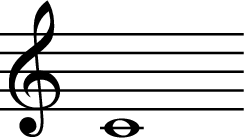
If your ocarina is in G, this reference note would be a G:
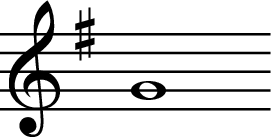
The same idea applies to ocarinas in other keys. The fingering shown above will sound the same note as named in the instrument's key, and that's the note position you want to remember.
Recognising intervals in sheet music
The distance between two notes is called an 'interval', and we count them as follows:
- Two notes of the same pitch are called a 'unison'.
- Two notes one staff position apart (for example, one note on a line and the other in an adjacent space) are called a 'second'.
- Two notes that are two positions apart (for example, one note on a line and another on a neighbouring line) are called a 'third'.
Larger intervals follow the same pattern: fourth, fifth, sixth, seventh, eighth (octave), and so on. Here are these intervals in relation to the low C.

Spend some time writing out different intervals from low C on a blank sheet of music paper and practice identifying them. If you have someone else around, it's a good exercise to practice together.
Moving by interval on the ocarina
Next, let's consider how a movement by an interval from the reference note mentioned before would relate to an ocarina in the same key.
Moving by an interval on the ocarina entails changing your fingering to move between those two notes. On a C ocarina, for example, the following notation represents moving upwards by a third from C to E.
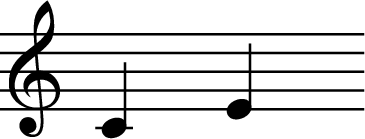
Referencing the partial fingering chart below, one can see that moving by this interval would entail lifting the right pinky and ring finger:

But what about the following notation and a G ocarina? The interval is a third from G to B. If you check the fingering chart below, what finger movements would you need to make to perform it?
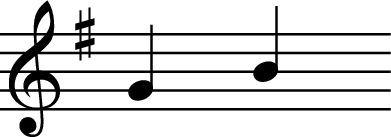

You'll find that the physical action you need to make for both the C and the G ocarina is precisely the same for their respective notation: you lift your right pinky and ring finger. This is so because both represent the same movement within their respective scales.
This realisation is the key to playing music on ocarinas in different keys at written pitch. If you have a reference note, you can read all of the following notes by interval and perform the corresponding intervals on the instrument.
Reading music by interval
One of the great things about intervals is that they are relative. The notation below, for example, shows several different diatonic thirds; some are descending, others ascending. If the note is two staff positions higher or lower, it is still an interval of a diatonic third.

Because intervals are relative, you can read and perform several intervals in series. If you consider the following notation:

- The first interval would move you up a third from C to E, thus lifting your right pinky and ring finger.
- Then, beginning on the E, you can notice that the next interval is a descending second, and perform this by lowering your right ring finger again.
If you have a reference note, you can read all of the following notes by interval, noticing and performing the corresponding intervals on the instrument. This works regardless of the key of the ocarina.
Consider how you would perform these two fragments on a C ocarina and a G ocarina, respectively.
C ocarina

G ocarina

If the key of the ocarina and the key of the music are different, a slight complexity arises, but we will address that later.
Let's play some music at written pitch
To put this into practice, let's consider how to play the following tune on a G ocarina:
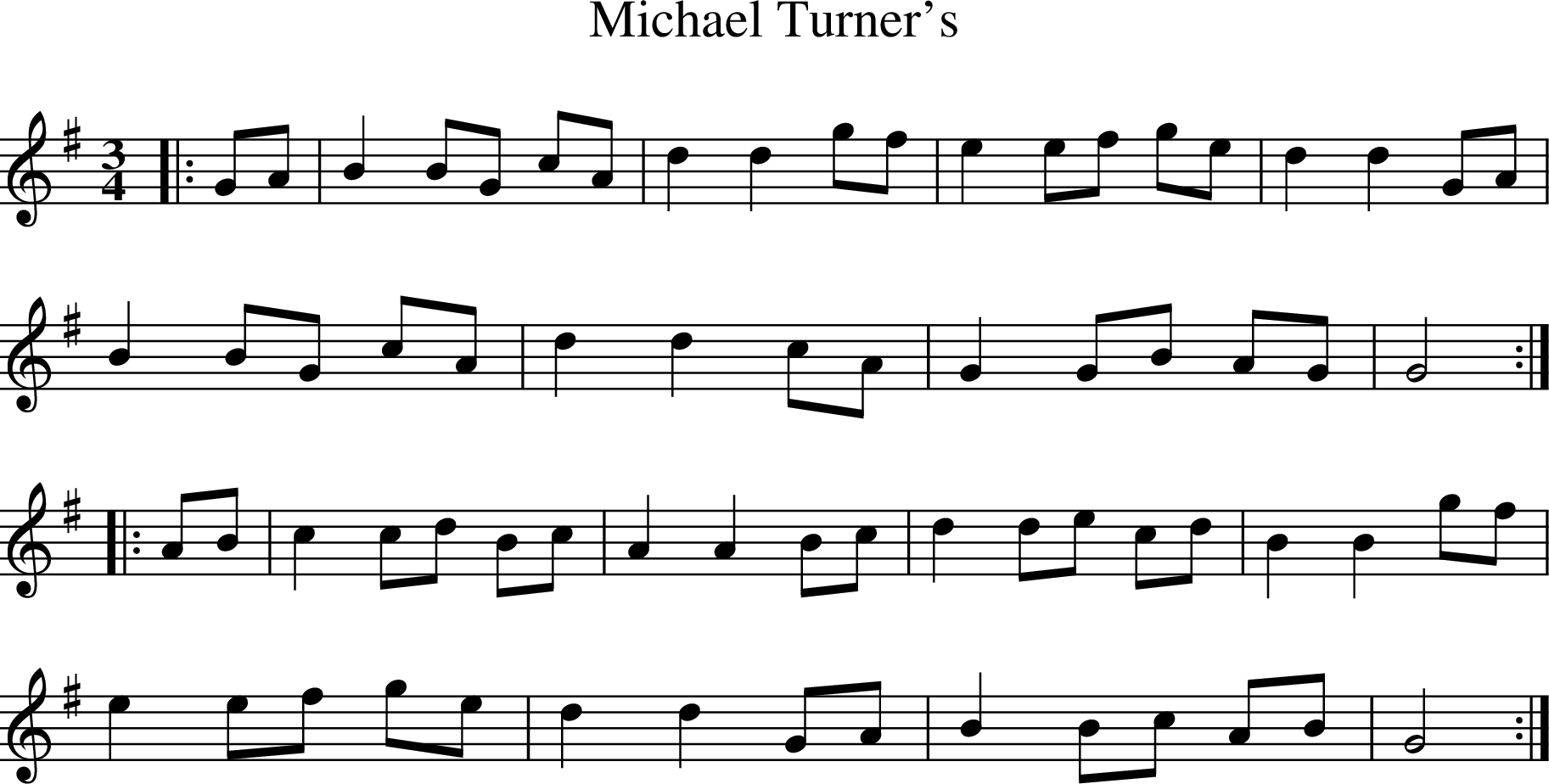
First, have a look over the music and notice some basic things:
- If you scan through the notes, you will notice that the tune has a range of one octave, G to G, and thus fits perfectly on a G ocarina.
- As the F♯ in the key signature already exists in the instrument's scale, it can be ignored.
- The tune starts on the G on the second line of the staff, which is the same as our reference note.
With this basic understanding in place, you can read the tune by noticing the intervals within the music and performing them on your G ocarina.
- Start by clapping through the rhythm if you wish, so that you know roughly how the music will sound.
- The interval between the first and second notes is a second, so lift the right pinky.
- The following note also moves up by a second, so lift the ring finger.
- Between notes 3 and 4 is also a second, but note 4 to 5 descends two positions (a third), so you lower both the ring and pinky fingers again.
- The rest of the tune can be read following the same approach.
The goal here is to associate the intervals' visual patterns directly with the muscle memory needed to perform them, without naming or otherwise labelling the notes.
As your experience grows, you can expand from looking at the interval between two note pairs to groups of three, four, or more notes at once. It's like reading a waveform drawn by the groups of notes: the larger the interval between the notes, the more pronounced the hooks, peaks or valleys in the waveform.
Getting good at this depends on two things: internalising the scales and intervals on your instrument, and learning to recognise and perform common melodic figure patterns.
Learning more reference points
As long as we know how our ocarina's reference note relates to the staff and can recognise the intervals used in the music, we don't need to name any of the notes. However, there are a few cases where things can get confusing:
- If the melody starts on a note that isn't the same as the reference note.
- In long music that uses large leaps, it can be easy to get lost.
It is always possible to find a note on your instrument by imagining the interval between the reference note we have discussed above and the note you are looking for. This can occur, for example, when the first note of a melody is not the same as the scale tonic. Look at the interval between them, ascend by that much in the scale, and start from there.
But it also helps to learn a few more fixed reference positions between the staff and the fingerings on the instrument.
Learning the major triad of your ocarina's key is a good option. A triad is a broken chord, which is a selection of notes based on a stack of three thirds. See 'Harmony for ocarina players'.
On a G ocarina, these notes are G, B, and D:
- The closed fingering is G.
- When you lift two fingers in sequence, you get B.
- Lifting two more fingers gives you D.
- Then you have another G and B, an octave higher.

To learn these notes, you can loop through them, performing the fingerings while saying their names. Use the chord notes of your own ocarina, which can be found by searching for the name of the chord online.
Using these reference points, it is easy to work out every other note by reading by interval. Every other diatonic note is only one step away from any of these. For instance, F♯ is one down from G, and E is one up from D. You can give this a try on the following tune.

As you spend more time playing on a given ocarina at written pitch, you will associate the fingerings directly with the note positions for that key.
Accounting for differences in the key signature
The previous method works perfectly if the range of notes and the key of the ocarina you are using match. But what if they don't? Say, for instance, with music that fits well in the range of a G ocarina but uses two sharps?
You just need to work out what accidentals you need to use by looking at the differences in the key signature:
- Write out the names of the accidentals in your ocarina's key. For example, if your ocarina is in G, this would be 'F sharp'.
- Write out the names of the accidentals for the key of the music. For example, if the music is in D, you'd have 'F sharp' and 'C sharp'.
Now, you just look at the difference between them. Here, we would need to add a C sharp to the scale, so you would look at your instrument's fingering chart and find out how to finger that note.
Practice this sequence of fingerings until it becomes muscle memory and you can play it easily. You may already know that fingering sequence as a given scale name on some other ocarina.
The same applies to other keys. To play in C major on a G ocarina, for instance, you'll have to replace your instrument's native F♯ with F natural.
Do note that while the fingerings of the major scale remain consistent for all ocarinas following a given system (Asian or Italian, for example), the best-tuned fingerings for accidentals vary between ocarinas.
This occurs due to differences in chamber acoustics, especially among ocarinas in different octaves (i.e. bass, alto, and soprano). Check your ocarina's fingering chart, or try several fingerings with a chromatic tuner to see what sounds best.
Pretending your ocarina is in a different key
If you don't have an ocarina in a given key, you can play as if the instrument you are holding were in that key; everything will work out, and the effect would be to transpose the music (see below).
Then, when you do get an ocarina in the key you were pretending to have, the music will sound in the correct pitch.
Handling accidentals in the body of the music
Knowing the chromatic scale is helpful if the music you are playing has accidentals.
- First, practice playing the chromatic scale sequentially, until you can perform it easily.
- Go through every note on your instrument and practice sharpening and flattening them by a semitone.
- Find or create some sheet music that uses accidentals and practice reading those while playing.
I'd advise learning to read music in the same key as the instrument first. Then, learn to play using a few accidentals in the key signature. Only once that is comfortable for you should you worry about accidentals in the body of the music.
Transposing at sight
The method described here also works for transposing at sight, and the process is almost the same.
- You have some music notated in C major, but you need it to sound in D. This can be done by playing it on a D ocarina, pretending that the instrument is in C.
- Say that you wanted to play the G range music and have it sound in C. That can be done by playing a C ocarina, but fingering it as if it were a G ocarina.
The rule here is first to determine what ocarina you would need to play the music at its intended written pitch, including any accidentals, if the instrument's key and the noted pitch differ.
Then, to transpose it, you would, in fact, play the music on an ocarina in a higher or lower key. Every semitone that the key of the instrument differs from the key of an instrument that would sound the music at its original pitch will have the effect of transposing the music up or down by that number of semitones.
Closing notes
You've learned the basics of how to play sheet music on ocarinas in different keys at written pitch. It is pretty straightforward and a great skill to have in your toolkit. It will open your eyes to music you may have otherwise considered impossible to play due to range.
This skill is also invaluable when playing with other musicians. Say you have an opportunity to play with someone on the spot, being able to play at written pitch means that it's easy to work out what instrument you need to do so. It is so much easier and faster than needing to transpose things manually.
